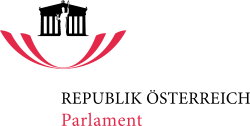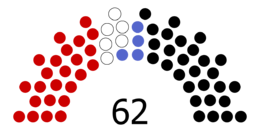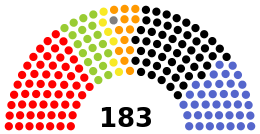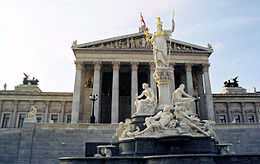Austrian Parliament
| Austrian Parliament Österreichisches Parlament | |
|---|---|
 | |
| Type | |
| Type |
Bicameral |
| Houses |
Federal Council National Council |
| Leadership | |
President of the Federal Council | |
President of the National Council | |
| Structure | |
| Seats |
245
|
 | |
Federal Council political groups | |
 | |
National Council political groups | |
| Elections | |
| Appointment by State Landtags | |
| Proportional representation | |
Federal Council last election | Unelected House |
National Council last election | 28 September 2008 |
| Meeting place | |
 | |
|
Parlament Innere Stadt, Vienna Republic of Austria | |
| Website | |
| Official Website | |
 |
| This article is part of a series on the politics and government of Austria |
| Constitution |
|
Executive
|
|
Legislature |
| Judicial system |
|
Administrative divisions |
| Foreign relations |
|
Politics portal |
The Austrian Parliament (Österreichisches Parlament) is the institution vested with the legislative power of the Republic of Austria. It consists of two chambers ,
- the National Council (Nationalrat) and
- the Federal Council (Bundesrat).
National Council
|
Federal Council
|
| Federal Assembly
(joint session of both houses) | |
The National Council is composed of 183 members elected through proportional representation in a general election. This happens every five years, or earlier if the National Council prematurely moves for its own dissolution. The National Council is the dominant (albeit 'lower') house in the Austrian Parliament, and consequently the terms Parliament and National Council are commonly used synonymously.
The Federal Council is elected indirectly, through the provincial Diets (Landtage) of the nine States of the Federal Republic. The states are represented in the Federal Council roughly in accordance to the size of their populations. Seats are redistributed among the states following each general census, and the overall size of the chamber varies slightly as a result. The current Federal Council is composed of 62 delegates. With regard to most issues, the Federal Council only possesses a dilatory right of veto which can be overridden by the National Council. However, the Federal Council enjoys absolute veto powers over bills intended to alter the powers of either the states, or of the Federal Council itself.
The Federal Assembly (Bundesversammlung) is a body whose function is mostly ceremonial in nature, and consists of the members of both houses of Parliament. The Federal Assembly convenes only rarely, for instance to witness the inauguration of the Federal President. It might be noted, however, that under exceptional circumstances the Austrian constitution endows the Federal Assembly with significant responsibilities. An example of this would be its pivotal role in the hypothetical impeachment of a Federal President.
Both houses of Parliament, as well as the Federal Assembly, convene in the Parliament building located on Vienna's Ringstraße.
See also
- Constitution of Austria
- Austrian Parliament Building
- Imperial Council (Austria)
- Imperial Diet (Austria)
External links
| Wikimedia Commons has media related to Parliament of Austria. |
| ||||||||||||||||||
Coordinates: 48°12′29″N 16°21′33″E / 48.20806°N 16.35917°E